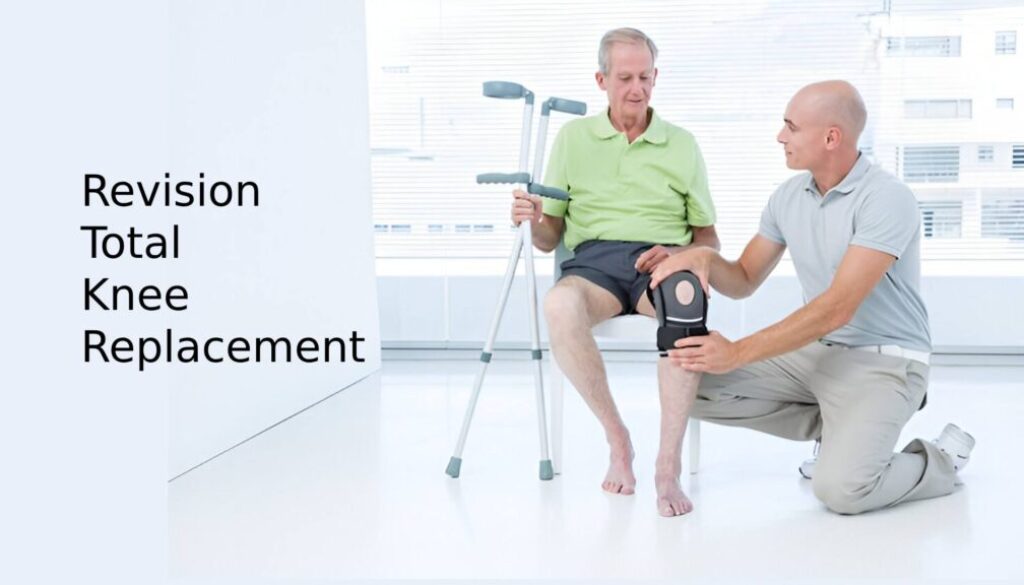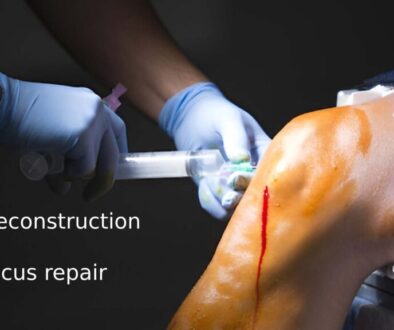Revision Total Knee Replacement: Causes, symptoms & Recovery
Introduction
Total knee replacement (TKR) is a highly successful procedure designed to relieve pain and restore function in patients suffering from severe knee arthritis or other joint issues. However, over time, some patients may experience complications that require further intervention. This is where revision total knee replacement comes into play.
A revision total knee replacement is a surgical procedure that replaces a previously implanted knee prosthesis with a new one due to implant failure, infection, or mechanical complications. Unlike a primary knee replacement, revision surgery is more complex and requires meticulous planning and execution by an experienced orthopedic surgeon.
This article will explore everything you need to know about revision total knee replacement, including why it is necessary, symptoms indicating the need for revision, preoperative evaluations, the surgical procedure, recovery process, and potential risks.
Understanding Total Knee Replacement (TKR)
What is a Total Knee Replacement?
A total knee replacement (TKR), also known as total knee arthroplasty (TKA), is a surgical procedure in which a damaged or diseased knee joint is replaced with an artificial implant. This procedure is commonly performed on individuals suffering from osteoarthritis, rheumatoid arthritis, or post-traumatic arthritis.
The goal of a TKR is to alleviate pain, improve mobility, and enhance the patient’s overall quality of life. The prosthetic knee consists of metal and plastic components that replicate the function of a natural knee joint.
How Does a Knee Implant Work?
A knee implant consists of three main components:
- Femoral Component: Attaches to the thighbone (femur)
- Tibial Component: Connects to the shinbone (tibia)
- Patellar Component: Replaces the kneecap (patella)
The smooth surfaces of these components allow for pain-free movement, simulating a natural joint.
Common Reasons for TKR Failure
Although TKR is a durable and effective solution, it is not always permanent. Over time, patients may experience:
- Implant wear and tear due to prolonged use
- Mechanical loosening of the prosthesis
- Infections that compromise the integrity of the implant
- Fractures around the knee joint
- Alignment issues leading to instability and pain
When a TKR fails, revision surgery may be necessary to correct the problem and restore knee function.
What is Revision Total Knee Replacement?
Definition of Revision TKR
Revision total knee replacement is a surgical procedure in which a failed or problematic knee implant is removed and replaced with a new prosthesis. It is a more challenging and technically demanding procedure than a primary TKR due to scar tissue formation, bone loss, and potential infections.
Differences Between Primary and Revision Knee Replacement
Feature | Primary Knee Replacement | Revision Knee Replacement |
Complexity | Less complex, straightforward | More complex, requires advanced techniques |
Surgery Time | Shorter (1-2 hours) | Longer (2-4 hours) |
Bone Preparation | Minimal bone removal | May require bone grafting or specialized implants |
Recovery | Faster and easier | Longer and more challenging |
Types of Revision Knee Replacement
Not all revision knee replacement surgeries are the same. The type of revision surgery needed depends on the specific problem with the original knee implant. Some cases require only a minor adjustment, while others require a complete reconstruction. Here are the different types of revision knee replacement surgeries:
1. Partial Revision Knee Replacement
- This is the least invasive type of revision surgery.
- Only one part of the implant (either the femoral, tibial, or patellar component) is replaced while leaving the remaining parts intact.
- Suitable for patients whose implant is mostly in good condition but has one failing component due to wear and tear or minor misalignment.
2. Total Revision Knee Replacement
- In this procedure, the entire knee prosthesis is removed and replaced with a new one.
- It is required when multiple components of the implant have worn out, loosened, or failed due to infection, mechanical issues, or fractures.
- Surgeons may need to use larger and more specialized implants to provide extra stability, especially if there has been significant bone loss.
3. Two-Stage Revision Knee Replacement (For Infections)
- This is the gold standard treatment for deep infections in a knee replacement.
- Stage 1: The surgeon removes the infected implant and thoroughly cleans the knee joint. A temporary antibiotic spacer (a special implant infused with antibiotics) is placed in the knee to help eliminate the infection.
- Stage 2: After 6 to 12 weeks, once the infection is cleared, the surgeon performs another surgery to implant the new permanent knee prosthesis.
This approach helps prevent reinfection and improves the long-term success of the revision knee replacement.
4. Complex Revision Knee Replacement
- Some patients require a more advanced reconstruction due to severe bone loss, multiple failed implants, or extreme instability.
- Specialized implants, such as hinged knee prostheses or bone grafts, may be used to rebuild the knee and restore proper function.
- This type of surgery requires highly skilled orthopedic surgeons and extensive preoperative planning.
Reasons for Revision Total Knee Replacement
Several factors may necessitate a revision TKR, including:
1. Implant Wear and Tear Over Time
Artificial knee joints are designed to last 15 to 20 years, but high-impact activities, excessive weight, or general wear can lead to the gradual breakdown of the prosthesis. As the materials degrade, the implant loses its effectiveness, causing pain and mobility issues.
2. Infection in the Knee Joint
Infection is a serious complication that can occur immediately after surgery or years later. Symptoms include:
- Persistent knee pain
- Redness and swelling
- Drainage from the surgical site
- Fever and chills
If an infection is confirmed, a revision surgery is necessary to remove the infected implant, administer antibiotics, and replace the prosthesis.
3. Mechanical Loosening or Instability
A knee implant may become loose due to inadequate fixation, excessive activity, or weakened bone structure. Symptoms include instability, pain, and difficulty walking.
4. Fractures Around the Implant
Periprosthetic fractures occur when a bone near the implant breaks due to trauma, osteoporosis, or implant stress. Severe fractures often require revision surgery to restore knee stability.
5. Patient-Related Factors
Certain medical conditions and lifestyle factors can accelerate implant failure, including:
- Obesity
- High-impact activities (running, jumping)
- Poor bone health (osteoporosis)
- Autoimmune diseases affecting joint health
Symptoms Indicating the Need for a Revision Surgery
Recognizing the warning signs early can prevent further complications. Some symptoms that indicate a failing knee implant include:
1. Chronic Knee Pain
Persistent pain that worsens over time is a red flag. Pain may be caused by implant loosening, infection, or improper alignment.
2. Swelling and Inflammation
Ongoing swelling in the knee joint, especially if accompanied by redness and warmth, could indicate infection or implant issues.
3. Reduced Mobility and Stiffness
A well-functioning knee implant should allow for smooth movement. If stiffness or difficulty bending the knee develops, revision surgery may be necessary.
4. Instability or Difficulty Walking
If the knee feels unstable, gives out, or has difficulty supporting weight, this could be a sign of implant failure.
5. Signs of Infection
- Fever and chills
- Pus or drainage from the incision site
- Increased pain and swelling
Any of these symptoms should be evaluated by a healthcare professional promptly.
Preoperative Evaluation and Diagnosis
Before proceeding with revision surgery, a thorough assessment is conducted to determine the underlying cause of implant failure.
1. Clinical Assessment and Patient History
The surgeon will review the patient’s medical history, symptoms, and any previous knee surgeries to understand the root cause of the problem.
2. Imaging Tests (X-ray, MRI, CT Scan)
- X-rays: Identify implant loosening, fractures, or misalignment
- MRI or CT scans: Detect soft tissue damage, infections, or bone loss
3. Blood Tests and Infection Screening
Blood tests help identify infections by checking for elevated white blood cells and inflammatory markers. Joint fluid aspiration may also be performed to confirm infection.
4. Consultation with an Orthopedic Specialist
An experienced orthopedic surgeon will discuss the findings and recommend the best approach for revision surgery, ensuring the patient understands the risks and benefits.
The Revision Total Knee Replacement Procedure
Revision total knee replacement is a complex surgery that requires precision and expertise. The procedure involves removing the old implant, preparing the knee for a new prosthesis, and ensuring proper alignment and stability.
1. Preparing for Surgery
Before the operation, patients undergo a series of preoperative steps to ensure they are fit for surgery. These include:
- Medical clearance: A full evaluation of overall health, including blood tests and heart function tests.
- Medication review: Adjustments to medications, such as stopping blood thinners before surgery.
- Preoperative physical therapy: Exercises to strengthen muscles around the knee and improve recovery outcomes.
- Infection prevention: Skin cleansing and antibiotic administration to reduce infection risks.
2. Anesthesia and Incision
- The patient is given either general anesthesia (put to sleep) or spinal anesthesia (numbing the lower body).
- The surgeon makes an incision over the knee, typically along the original scar from the previous surgery.
3. Removal of the Old Implant
- The existing knee implant is carefully extracted.
- Any damaged bone or scar tissue is removed.
- If there is significant bone loss, bone grafts or special implants may be used to rebuild the area.
4. Inserting the New Implant
- The surgeon selects a suitable revision knee prosthesis.
- Metal and plastic components are implanted using bone cement or special fixation techniques.
- The new knee implant is tested for alignment, movement, and stability.
5. Closing the Incision and Recovery Room Monitoring
- Once the implant is secure, the incision is stitched or stapled.
- A drain may be placed to remove excess fluid.
- The patient is taken to the recovery room for monitoring before being transferred to a hospital bed.
Recovery Process After Revision Total Knee Replacement
Recovery from revision knee surgery is often longer and more challenging than primary knee replacement. However, with proper care and rehabilitation, most patients regain mobility and function.
1. Hospital Stay and Immediate Post-Surgery Care
- Patients typically stay in the hospital for 3 to 7 days.
- Pain is managed using medications, including opioids (short-term), anti-inflammatories, and ice therapy.
- Physical therapy begins within 24 hours after surgery to prevent stiffness and promote mobility.
2. Physical Therapy and Rehabilitation
- First 6 weeks: Focus on regaining motion, reducing swelling, and strengthening muscles.
- Weeks 6-12: More advanced exercises, including walking with minimal assistance.
- 3 to 6 months: Patients can return to daily activities with little to no discomfort.
3. Home Recovery Tips
- Follow a balanced diet rich in protein and calcium to support healing.
- Use mobility aids (walker, crutches) as needed.
- Keep the knee elevated and apply ice to reduce swelling.
- Avoid high-impact activities until cleared by the doctor.
Potential Risks and Complications of Revision TKR
As with any major surgery, revision total knee replacement carries some risks. These include:
1. Infection Risks
- Deep infections may require further surgery.
- Signs of infection include fever, swelling, and drainage.
2. Blood Clots (Deep Vein Thrombosis – DVT)
- Blood thinners and compression stockings help prevent clots.
- Symptoms include leg pain, redness, and swelling.
3. Implant Loosening or Misalignment
- Some implants may not integrate properly, requiring additional correction.
4. Nerve or Blood Vessel Damage
- Rare but can lead to numbness or circulation issues.
5. Limited Range of Motion or Stiffness
- Aggressive physical therapy helps prevent this complication.
Life After Revision Total Knee Replacement
Most patients experience significant pain relief and improved mobility after recovery. However, adjusting to a new implant requires lifestyle changes.
1. Expected Outcomes
- Pain relief: Most patients feel 85-90% improvement in pain levels.
- Improved function: Walking, climbing stairs, and daily activities become easier.
- Longevity: A revision implant lasts 10-20 years, depending on usage and health factors.
2. Long-Term Care for Knee Health
- Maintain a healthy weight to reduce stress on the implant.
- Engage in low-impact exercises like swimming and cycling.
- Avoid high-impact activities like running and jumping.
- Schedule regular check-ups to monitor the implant’s condition.
Conclusion
Revision total knee replacement is a complex but effective procedure for addressing failed knee implants. While recovery takes time, the surgery significantly improves the quality of life for patients dealing with pain, instability, or implant complications. Proper rehabilitation and long-term care ensure a successful outcome and prolonged implant durability.
FAQs
1. How long does revision knee replacement surgery take?
Revision TKR takes between 2 to 4 hours, depending on the complexity of the case.
2. Is revision knee surgery more painful than the first knee replacement?
Yes, revision surgery is often more painful due to increased surgical complexity, but pain management strategies help alleviate discomfort.
3. What activities can I do after a revision knee replacement?
Patients can engage in walking, swimming, cycling, and gentle stretching, but should avoid high-impact sports like running.
4. How soon can I walk after revision total knee replacement?
Patients start walking with assistance within 24 hours, but full mobility takes several weeks to months.
5. What are the signs that a knee implant is failing again?
Persistent pain, swelling, instability, or difficulty bending the knee are signs of implant failure and should be evaluated by a doctor.



